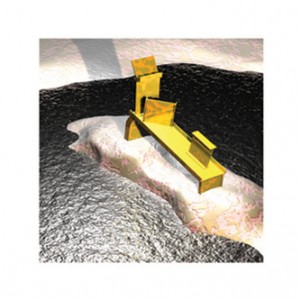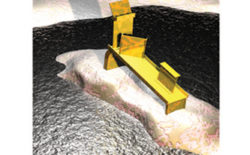Available on: NNA Tapes LP
A split LP is still quite a rarity these days, so a pairing of Oneohtrix Point Never and Rene Hell was always going to be something quite pronounced and purposeful. With both artists having transitioned in the last two years from synth-lead constructions to more electroacoustic compositions, Music For Reliquary House / In 1980 I Was A Blue Square is definitely A Good Idea as far as a showcase of new music goes.
As Oneohtrix Point Never, Daniel Lopatin takes the first half of the record with Music For Reliquary House, a single, 22 minute composition picking up from the primarily sample-based material of last album Replica and his harsher noise interests.
Between the more ‘studio-based contemporary classical’ approach of this work and the implications of its title – a holy home for religious relics – there is something familiar about it in both its selection of instrumentation and content. The voice, as with much sacred music, plays a consistently dominant role within swathes of noise, both elements presented as long streams, violent gestures and occasional rhythmic patterns. Lopatin takes a Ligeti-like approach to reverence, focusing more on a harrowing awe of the almighty than hallowed worship. Music For Reliquary House is a sustained drama of constant builds and drops in intensity, an extremely slow pan taking in fearful, transcendental details.
Creating any long-form electroacoustic piece is a challenge and, as with any genre, there are certain approaches that result in clichés. Music For Reliquary House is slightly different in that it is coming from a noise-based, live laptop-and-MIDI-controller kind of aesthetic (also something of its own sound), resulting in a mixture of the two methods.
As such there are familiar tropes from both, but an abundance of detail from the two colliding, with perhaps some give and take necessary. As an example, the use of constant speech-fragment chattering found throughout – much like repeated sample triggering from varying pressure on a controller pad – is quite grating. However, the same technology (presumably) and this kind of DIY computer-punk aesthetic also result in some vicious movement and content less common to electroacoustic music.
Where the piece holds its own is by neatly sidestepping again and again into territory unexpected both for the type of composition it is and in a more general musical sense: stuttering rave stabs; contorted, strained synth tones; sparser, warped vocal transitions, fleeting bursts. Rather than moving as one single trajectory from A to B, with new material regularly introduced, it could have benefitted from revisit some of these moments. However, with a huge amount of inspiration crammed in toMusic for Reliquary House there is enough to make for a dynamic total listen, a regular shift between the familiar and its surprising transitions and combinations.
Jeff Witscher, a.k.a. Rene Hell, then takes the second half of the album, In 1980 I Was A Blue Square. A simple comparison of his current progression in style would be between CFCF, Telafon Tel Aviv’s early work and Hecker; a marrying of neo-Classical and minimalist styles with both electronic instruments and computer-generated sonics.
‘Meta Concrète’ enters with what sounds like a clock irregular chiming an obtuse melody behind a delicate, sombre piano 12/8 piano ballad, everything quickly torn asunder by collapsing swathes of digital noise and the pattering of crushed frequency blips. The veil of string arrangements that follow in ‘Quelque Terreur’ are hair-raisingly beautiful, simple and effective, electronics used sparingly in its floating cloud of glitchy, bird-like chirruping and possibly some pads to fill out the chords.
‘Prelude To The Bridge’ then pairs a Glass- or Nyman-like piano adventure with complimentary synthesizer, mournful strings and frantic frequency fits atop, an extraordinary 21st Century romantic adrenaline rush. ‘Variation In C’ changes pace, moving as growing and fading blocks of what might be real woodwind, organ-like tones, and strings. Swelling lushly again and again from warm harmony to warm harmony, the strings reach to take brief, dominant, expressive roles in the latter third.
‘Bl, Qs’ finishes Hell’s contribution, almost a slow variation on the opening number in its 12/8 piano arpeggiations, joined this time by earnest vibrato and sul ponticello strings. While there are no electronics present, the quiet, introverted clock bell tones return too, curious in their restraint, distance and ambiguity.
In 1980 I Was A Blue Square is a superbly considered collection of miniatures. While the premise of pairing naïve, genuinely lovely classical compositions with the extremities and subtleties of sonic technology is a simple idea, the ability to do so successfully, featuring them together in such a way that the pieces are unfinished without one or the other, is far harder. Hell has done so, modestly and with highly commendable results.

































